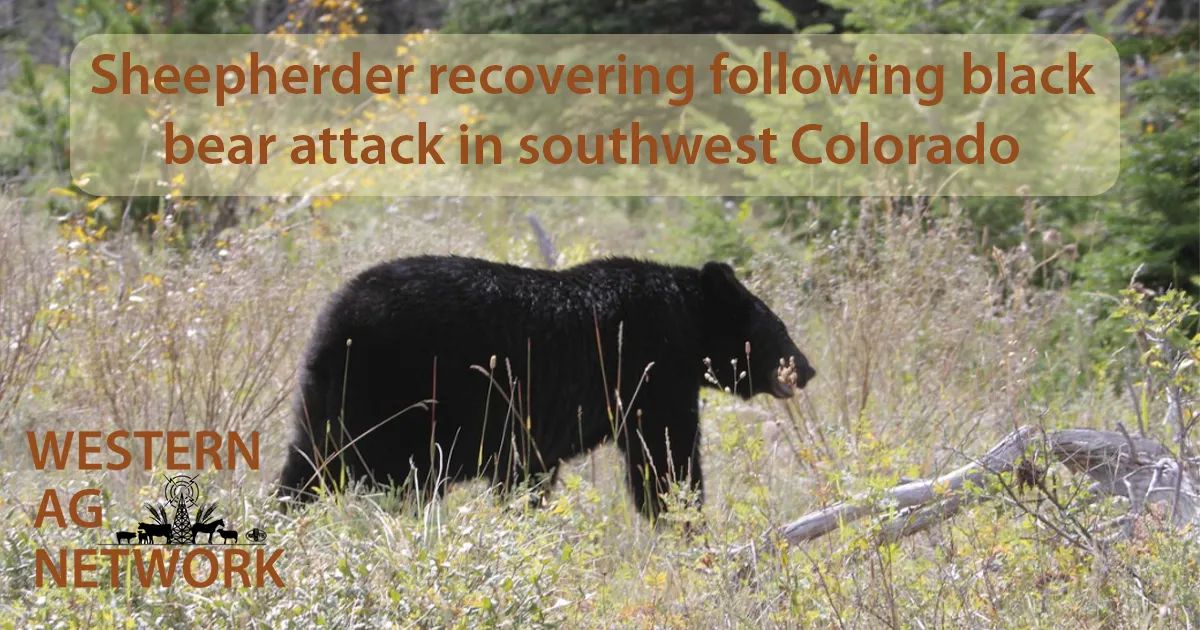
Peruvian Herder Attacked In Colorado After Interrupting Bear Depredation
July 14, 2023
DURANGO, CO.— A Peruvian sheepherder is recovering following surgery to treat injuries sustained in a black bear attack. David Vasquez, 35, was attacked while tending about 750 ewes with lambs in the Weminuche Wilderness, 23 miles northeast of Durango near Lemon Reservoir, on Tuesday morning.
Vasquez works for sheep rancher J. Paul Brown, who said he was able to call the ranch in the early morning hours following the attack. Brown said a man was able to move quickly up the trail to meet the medevac team from Mercy Regional Medical Center in Durango. He was transferred to Grand Junction and treated for facial lacerations, a broken arm, and puncture wounds.
This is Brown’s 53rd summer in the Weminuche. He said a bear woke him in his bedroll some 40 years ago, but an attack like this hasn’t occurred, something Brown attributes to the Colorado Parks and Wildlife management of black bears. CPW manages bear populations primarily through hunting, though he said a ballot initiative reducing bear hunts in the state in 1992 took that tool away from the agency.
“We’ve never had this happen before to any of our men, nobody’s ever been attacked,” Brown said. “He went out that night and checked the sheep and that bear was right there growling at him.”
Brown said Vasquez shot the bear and while his dog fought to protect him, Vasquez slipped and the bear “was on top of him.”
“We’re very thankful that he’s going to be all right,” he said. “He’s going to be scarred up, but he’s going to be all right. He has some puncture wounds on his thigh and groin area, and a broken arm where he put his arm up to protect himself where the bear was trying to bite his head.”
CPW officials gathered DNA samples from Vasquez and officers on scene found two sheep carcasses with wounds consistent with a bear attack. An agent with USDA’s Animal and Plant Health Inspection Service (APHIS) was called and, using a team of dogs, he was able to locate a bear in the vicinity and shoot and kill it. The bear is estimated to be an 8-year-old male weighing 250 pounds. Officers found sheep wool in the bear’s stomach and are confident it was the animal responsible for the attack but will not be certain until DNA testing is completed.
In 1992, a citizen-led ballot initiative changed state statute to prohibit bear hunting from March 1 to September 1, eliminating the spring bear season as well as the use of bait or dogs. At that point, CPW estimated a black bear population of 10,000 to 12,000. In early 2023, the agency estimated between 17,000 and 20,000 bears.
Mark Vieira, CPW Carnivore and Furbearer Program Manager, said population estimates for bears are more difficult than deer or elk. CPW uses primarily sighting information reported to the agency, and the use of hair snag samples to use DNA to estimate bear populations.
CPW was directed by the 2015 General Assembly to study the issue of human-black bear encounters and provide information and recommendations to reduce conflicts (House Bill 15-1304). The enacted legislation directs the Division of Parks and Wildlife to “gather information about, consider, and evaluate all available management tools to enhance the Division’s ability to properly manage black bear populations year-round to address bear-human conflicts and public safety. The Division shall report its findings to the Agriculture Livestock, and Natural Resources committee of the House of Representatives and the Agriculture, Natural Resources, and Energy committee of the senate.”
In 1996, the Colorado Department of Agriculture received “exclusive jurisdiction over the control of depredating animals that pose a threat to an agricultural product or resource” giving it the sole authority to determine the disposition of an individual bear found depredating on livestock; however, CPW retains the authority to manage black bear populations, body parts and all forms of recreational or scientific use. A Memorandum of Agreement between the agencies provides operational guidance, helping assure documentation of agriculture-related bear deaths and the legal disposition of bear carcasses.
According to CPW, in 2002 the legislature limited the state’s liability for damages to $5,000 per head of livestock and to personal property used only for the production of raw agricultural products, effectively eliminating payments for non-agricultural personal property claims.
In 2015, CPW reported that bear depredation claims remained a significant portion of CPW’s budget, averaging approximately $300,000 annually over the last decade with occasional spikes up to $450,000. According to the 2022 Game Damage Report, $194,126 in damages paid for sheep depredations (688 count in 28 claims) and cattle (12 count in 10 claims) for black bear depredations. For bear and/or mountain lion depredations, $142,619 compensation was paid for sheep losses for 531 head in 8 claims.
Brown said during his time in the legislature, he tried to reinstate the spring bear hunts or establish special licenses for problem bears, but said he was unsuccessful.
“As we look at wolf introduction, that’s going to increase the problem,” he said. “As you know, we have way more people in Colorado than Montana, Wyoming, and Idaho together and there’s going to be human-wolf conflicts. That’s something people need to think about now. It’s good for people to know there are consequences when you don’t manage wildlife.”
Source: Fence Post Magazine and Western Ag Network










